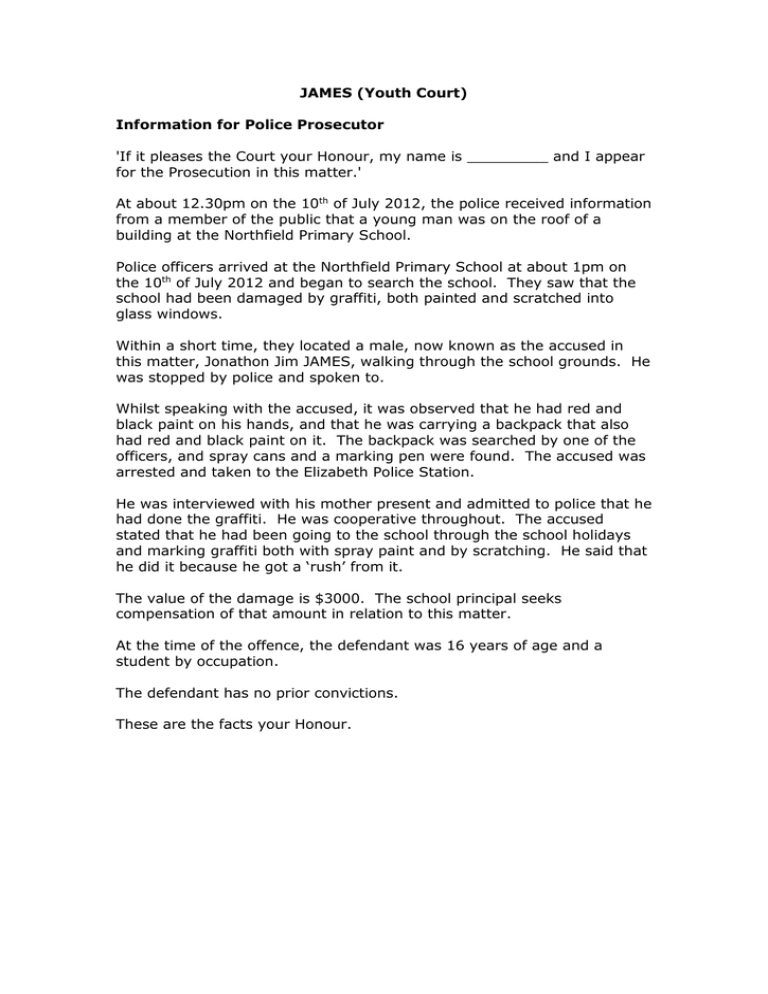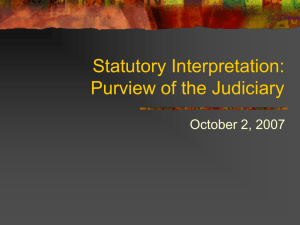James - Youth Court
advertisement

JAMES (Youth Court) Information for Police Prosecutor 'If it pleases the Court your Honour, my name is _________ and I appear for the Prosecution in this matter.' At about 12.30pm on the 10th of July 2012, the police received information from a member of the public that a young man was on the roof of a building at the Northfield Primary School. Police officers arrived at the Northfield Primary School at about 1pm on the 10th of July 2012 and began to search the school. They saw that the school had been damaged by graffiti, both painted and scratched into glass windows. Within a short time, they located a male, now known as the accused in this matter, Jonathon Jim JAMES, walking through the school grounds. He was stopped by police and spoken to. Whilst speaking with the accused, it was observed that he had red and black paint on his hands, and that he was carrying a backpack that also had red and black paint on it. The backpack was searched by one of the officers, and spray cans and a marking pen were found. The accused was arrested and taken to the Elizabeth Police Station. He was interviewed with his mother present and admitted to police that he had done the graffiti. He was cooperative throughout. The accused stated that he had been going to the school through the school holidays and marking graffiti both with spray paint and by scratching. He said that he did it because he got a ‘rush’ from it. The value of the damage is $3000. The school principal seeks compensation of that amount in relation to this matter. At the time of the offence, the defendant was 16 years of age and a student by occupation. The defendant has no prior convictions. These are the facts your Honour. Information for Defence Lawyer "If it pleases the Court your Honour, my name is __________, and I appear for the Defendant in this matter." This is my client’s first appearance before the court and he has no prior convictions. My client admits the facts as outlined by my friend. He instructs me that at the time of this offending, it was school holidays and he found himself in a position that he had not been in before. His mother and father had separated only one month earlier, and this caused great turmoil in his life. He and his mother moved out of the family home in Christies Beach, and moved into their home in Northfield. This meant that my client left his friends, family and support networks behind, and in the month that passed had not yet truly settled into his new situation. His mother also started working full time after the separation, and this meant that Jonathon was at home by himself during the school holidays. He made bad choices as to what to do with the time that he had, and this led him to expressing his anger, frustration and boredom through marking graffiti at the local primary school. As my friend stated, when Jonathon spoke to the Police, he was completely honest and made a full statement to them. Jonathon feels quite upset by what has happened and is very remorseful about what he has done. He attends at Northfield High School and is currently completing Year 12. He was in Year 11 at the time of the offence. Jonathon wishes to go on to study to be a Crime Scene Analyst at University, and is keen to finalise this matter at the earliest opportunity so that he can continue to focus on his studies. My client’s mother has been highly upset by this matter, but has come along to court today to support her son. He has been receiving a Youth allowance of $100 a fortnight. He pays $50 a fortnight in board to his mother, and uses the other $50 to pay for his mobile phone, bus tickets and other expenses. We ask the court to consider its powers under the Young Offenders Act 1993 and not require our client to pay compensation to the School. We also request that no conviction be recorded against our client in this matter. He realises that what he has done is wrong and would be happy to perform community service if the court sees fit to allow him to do so. EDUCATIONAL USE ONLY SOUTH AUSTRALIA (YOUTH COURT) Form 4 Court Use INFORMATION Magistrates Court of South Australia www.courts.sa.gov.au Summary Procedure Act, 1921 Sections 101 date filed Informant Name:. THE UNDERSIGNED MEMBER OF THE POLICE FORCE Address ELIZABETH CRIMINAL JUSTICE SECTION Defendant Name: JAMES, Jonathon Jim Address 251 NORTH ROAD, NORTHFIELD Offence details 1. On the 10th day of July 2012 at NORTHFIELD, in the said State, intending to damage the property of another or being recklessly indifferent as to whether such property was damaged, damaged two windows and several building the property of the Northfield Primary School, such damage amounting to more than $2,500.00, but not more than $3,000.00 Section 85(3) of the Criminal Law Consolidation Act, 1935 This is a minor indictable offence. 2. On the 10th day of July 2012 at NORTHFIELD, in the said State, carried graffiti implements, namely two spray cans and a marker with the intention of using them to mark graffiti. Section 10(1) of the Graffiti Control Act, 2001 This is a summary offence The informant may seek compensation The informant will seek forfeiture of the items On the date of the alleged offence, the youth was aged 16 years Other orders sought (forfeiture, compensation, additional penalty, destruction or the like – Rule 15.03) .............................. Date .......................................... Informant .......................................... Witness (Registrar, Deputy Registrar or Justice of the Peace) (Not required if Complainant is a Public Authority) CRIMINAL LAW CONSOLIDATION ACT 1935 Part 4—Offences with respect to property 84—Preliminary (1) In this Part— to damage in relation to property includes— (a) to destroy the property; (b) to make an alteration to the property that depreciates its value; (c) to render the property useless or inoperative; (d) in relation to an animal—to injure, wound or kill the animal, and damage has a corresponding meaning; owner of property means a person wholly entitled to the property both at law and in equity. (2) Where a person damages, or attempts to damage, property of which the person is not the owner, that property shall (whether or not that person has some legal or equitable interest in it) be regarded as property of another for the purposes of this Part. (3) In proceedings for an offence against this Part in which it is necessary to quantify damage or potential damage in terms of a monetary amount— (a) no regard shall be had to any reduction or possible reduction of the damage through the intervention of some person other than the accused; and (b) where actual damage occurred and was in fact reduced by such intervention, the damage shall be deemed to include the potential damage that was prevented by that intervention. 85—Damaging property (1) Where a person— (a) intending to damage property of another, or being recklessly indifferent as to whether property of another is damaged; and (b) without lawful authority to do so, and knowing that no such lawful authority exists, damages, or attempts to damage, property of another by fire or explosives, the person shall be guilty of an offence. Penalty: (a) for a completed offence— (b) (i) where the damage exceeds $30 000—imprisonment for life; (ii) where the damage exceeds $2 500 but does not exceed $30 000—imprisonment for 5 years; (iii) where the damage does not exceed $2 500—imprisonment for 2 years; for an attempt— (i) where the damage would, if the offence had been completed, have exceeded $30 000—imprisonment for 12 years; (ii) where the damage would, if the offence had been completed, have exceeded $2 500 but would not have exceeded $30 000— imprisonment for 3 years; (iii) where the damage would not, if the offence had been completed, have exceeded $2 500—imprisonment for 18 months. (2) The offence of damaging property by fire in contravention of subsection (1) is arson. (3) Where a person— (a) intending to damage property of another, or being recklessly indifferent as to whether property of another is damaged; and (b) without lawful authority to do so, and knowing that no such lawful authority exists, damages, or attempts to damage, property of another, the person shall be guilty of an offence. Penalty: (a) for a completed offence— (b) (i) where the damage exceeds $30 000—imprisonment for 10 years; (ii) where the damage exceeds $2 500 but does not exceed $30 000—imprisonment for 3 years; (iii) where the damage does not exceed $2 500—imprisonment for 2 years; for an attempt— (i) where the damage would, if the offence had been completed, have exceeded $30 000—imprisonment for 6 years; (ii) where the damage would, if the offence had been completed, have exceeded $2 500 but would not have exceeded $30 000— imprisonment for 2 years; (iii) where the damage would not, if the offence had been completed, have exceeded $2 500—imprisonment for 1 year. (4) It is a defence to a charge of an offence against this section for the accused to prove an honest belief that the act constituting the charge was reasonable and necessary for the protection of life or property. 85A—Recklessly endangering property (1) Where— (a) a person does an act knowing that the act creates a substantial risk of serious damage to the property of another; and (b) the person does not have lawful authority to do so and knows that no such lawful authority exists, the person is guilty of an offence. Penalty: Imprisonment for 6 years. (2) It is a defence to a charge of an offence against this section for the accused to prove an honest belief that the act constituting the charge was reasonable and necessary for the protection of life or property. GRAFFITI CONTROL ACT 2001 PART 3 GRAFFITI OFFENCES Carrying graffiti implement 10. (1) A person who— (a)carries a graffiti implement with the intention of using it to mark graffiti; or (b)carries a graffiti implement of a prescribed class without lawful excuse in a public place or a place on which the person is trespassing or has entered without invitation, is guilty of an offence. Maximum penalty: $2 500 or imprisonment for 6 months. (2) For the purposes of this section the following classes of graffiti implement are prescribed: (a)graffiti implements capable of spraying paint or a similar substance; (b)graffiti implements designed or modified to produce a mark that— (i)is not readily removable by wiping or by use of water or detergent; and (ii)is more than 15 millimetres wide. Proof of lawful authority or excuse 11. Where this Part provides that an act done without lawful authority or lawful excuse constitutes an offence, the onus, in proceedings for such an offence, lies on the defendant to prove lawful authority or lawful excuse.





